An article on Midwest Industries handguard and trigger upgrades is pretty timely. I say this since I know that plenty of people were lucky enough to get a new AR15 this holiday season. If you did (or even if you already had one) and you want to upgrade it, Midwest Industries is here for you. That’s because for a lot of us, our rifles look like this:
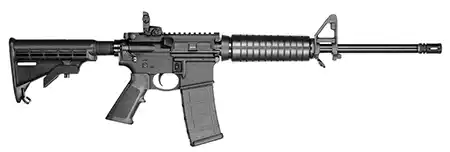
Swapping out the stock and grip is usually the first modification. But let’s be honest, that plastic handguard does the job, it’s just far from ideal. An aluminum one can be lighter, while providing mounting options for plenty of accessories. Many of us want to add a forward grip, vertical grip, handstop, and/or light. It depends on the individual use case. Magpul’s M-LOK system makes mounting all these items easy, without having to first add any rail sections. The downside is that many rifles didn’t come equipped with an aluminum handguard. If replacing your front gas block and cutting off your delta ring doesn’t sound appealing to you, the Midwest Industries drop-in handguards have got you covered.
Midwest Industries two-piece drop-in AR Handguard
These are two-piece aluminum handguards that drop in just like the plastic factory unit. They lock into place using the existing mounting points, and offer plenty of advantages over the basic handguard. Each features five anti-rotation QD sling sockets. That’s one each fore and aft at 3 and 9 o’clock, and one aft on the bottom. Up top is a full-length MIL-STD 1913 (Picatinny) rail. At 3, 6, and 9 o’clock are M-LOK slots. The rail length and amount of slots vary between carbine, mid, and rifle-length handguards, of course. When compared to the standard handguard, they add plenty of versatility.
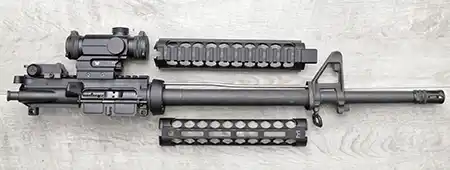
Height and width are the same for each one, at 2.25″ and 1.83″, respectively. Weights are 5 ounces for the carbine version, 6.6 ounces for the mid-length, and 8.5 ounces for the rifle length. That’s 2.3 ounces less than the polymer set they replaced. These are 100% USA-made, as you would expect. Constructed from 6061 aluminum with a black hardcoat finish, they’re designed for hard use. Midwest Industries backs that up with a lifetime warranty. Current prices run from $146.95 for the carbine version, and $157.95 for the mid-length (shown) to $167.95 for rifle length.
Installation
Replacing the plastic drop-in handguard is far easier than you might think. An inexpensive handguard removal tool can help, but it wasn’t even necessary for me. After making sure my rifle was unloaded, I pushed the pins through and took off the upper. Pulling back on the delta ring I removed the top half of the handguard. With that out of the way, I did the same for the bottom half.

Once they were both off, installing the Midwest Industries was relatively easy. Starting with the top half first, I pushed the nose into the handguard cap and then tucked the rear under the delta ring. Flipping my upper over, I did the same for the lower half of the handguard. Again, it goes in nose first, under the handguard cap. It’s a tighter fit with the top half in place, but not terrible. With a final hard pull on the delta ring, it was seated. I’m pretty sure it took me longer to type these instructions than it did to complete the installation. Using the tool probably would not have made it any easier, but rifles vary. Once done, I placed my upper back on the lower and pushed the takedown pins back in.
Mounting accessories
With the handguard now in place, adding M-LOK accessories is easy. I’m not a fan of vertical foregrips but do like the lower-profile ones with a barrier stop. I’ve also got a laser handstop to test out. And a weapon-mounted light. There’s no shortage of grips, lights, bipods, and more that can be mounted via M-LOK. Should I find that I still need some Picatinny rail, Midwest Industries even includes a short section with the handguard.
About that trigger…
Chances are your rifle also came with a generic “MIL-Spec” trigger. They’re fine, and generally make the rifle go bang every time. But the pull weight is usually 6-7 pounds. For a combat rifle, that may be okay, but most of us are looking for a bit more precision. Cutting some of the trigger pull weight can help, and it doesn’t need to involve swapping springs, which can affect reliable ignition. If you don’t want to mess with the springs or all the parts that make up your fire control group, a drop-in trigger is the way to go.
The Midwest Industries AR15 drop-in 3.5 lb single-stage trigger
Available with either a flat or curved trigger, this is another easy upgrade. It promises an “Ultra-smooth break with a crisp, clean release”. After installing one, I’d say they delivered on that. It’s CNC machined from aluminum and heat-treated tool steel. Interior parts utilize S7 tool steel with a black nitride finish. So it’s strong with plenty of corrosion resistance. With the 3.5 pound pull weight and a lightened hammer, it’s light and resets quickly.
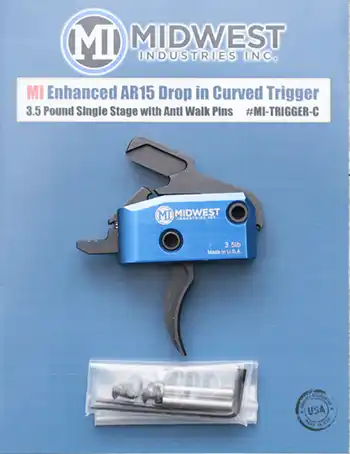
Trigger installation
Installing the trigger is a little more involved than the handguard, but it’s still nothing most enthusiasts can’t tackle at home. If your rifle isn’t already apart, then verify it’s unloaded, and separate the upper from the lower. Remove the grip first, being careful not to lose the spring or detent above it, which are both part of the safety. Carefully punch out the hammer pin, then remove the hammer and its spring. Do the same for the trigger spring, then remove the rest of the trigger components, as well as the safety.

Place the Midwest Industries trigger into the pocket of the receiver. Install the included anti-walk pins with the wrench and screws (also included in the package). Next, reinstall the safety selector and the detent. When installing the grip, make sure the spring for the safety is lined up with the detent, and then tighten down the grip. After the safety is installed, the trigger installation can be completed. This involves using the long allen wrench from the package to tighten down the two small set screws on either side of the trigger. I used a flat blade screwdriver to to slide the hammer springs over, making access easier. Snug them down, and don’t overtighten. Test the trigger and safety functions before installing the upper. Be sure to stop the hammer with your hand, rather than letting it smack your receiver.
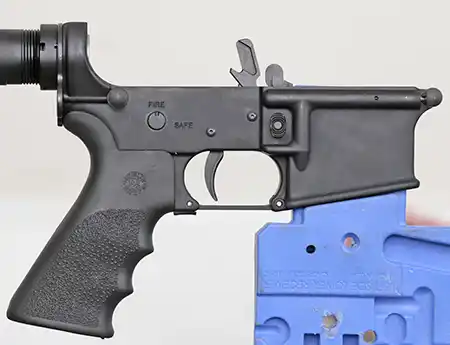
They didn’t lie about this trigger
Where the old trigger had a pretty heavy pull with a little grit in it, this one is completely different. No creep, no grit, just a nice clean break and a short reset. At 3.5 pounds, it’s no match trigger, but it’s exactly what I would want for sporting and defensive purposes. It strikes the perfect balance between weight and utility. It’s not so heavy that accuracy might suffer, but not so light that a flinch is going to cause a negligent discharge. I’ve got much lighter triggers, but they are in bolt actions, or semi-autos that are intended for use at the range only.
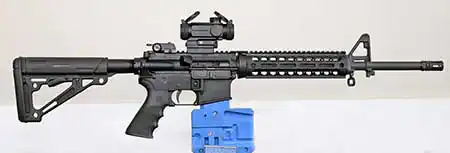
Conclusion
I’ve had this rifle for almost 18 years. It pre-dates M-LOK, but it’s also been perfectly reliable, so I hate to mess with it. Yet during the time I have owned it, I’ve honed my skills considerably. And I have also gotten some really nice triggers for other firearms. So the trigger upgrade was definitely due. Same with the handguard. As more and more products come out with the M-LOK mounting system, I had to use other rifles to try them out. Now this one looks and feels a little more modern. The Midwest Industries handguard and trigger upgrades kinda make it feel like a new rifle, but it’s still got a familiar feel to it.
If you’re in the same boat, then know this: You can easily do more than just a stock and grip upgrade at home. Midwest Industries makes it easy and affordable. Their drop-in handguard is comparable in price to a one-piece unit, but without modifying your rifle or buying more tools. And their trigger can help improve accuracy without affecting reliability. It’s a win-win here. So whether you want to breathe new life into an old rifle, or upgrade a new one, check out all the great gear available at midwestindustriesinc.com.
As always, I’d like to thank Midwest Industries for supplying their handguard and trigger for testing and evaluation.
